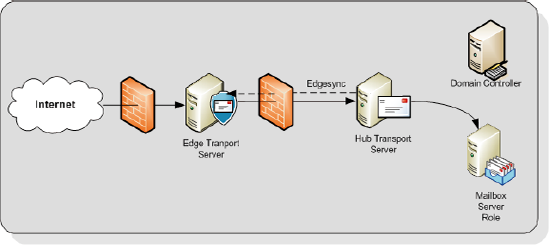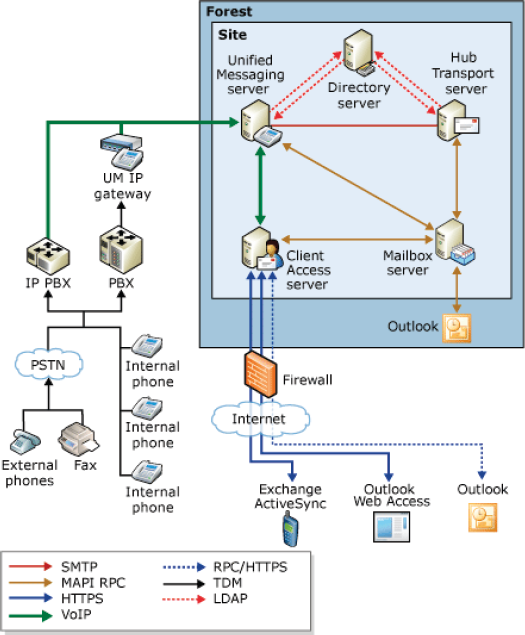4 Edge Transport Server (Edge) role
The Edge Server role was
introduced with Exchange Server 2007, and provides an extra layer of
message hygiene. The Edge Transport Server role is typically installed
as an SMTP gateway in the network's "Demilitarized Zone" or DMZ.
Messages from the Internet are delivered to the Edge Transport Server
role and, after anti-spam and anti-virus services, the messages are
forwarded to a Hub Transport Server on the internal network.

The Edge Transport Server can also provide the following services:
Edge Transport Rules
– like the Transport Rules on the Hub Transport Server, these rules can
also control the flow of messages that are sent to, or received from,
the Internet when they meet a certain condition.
Address rewriting
– with address rewriting, the SMTP address of messages sent to, or
received from, the Internet can be changed. This can be useful for
hiding internal domains, for example after a merger of two companies,
but before one Active Directory and Exchange organization is created.
The Edge Transport Server is
installed in the DMZ and cannot be a member of the company's internal
Active Directory and Exchange Server 2010 organization. The Edge
Transport Server uses the Active Directory Lightweight Directory
Services (AD LDS) to store all information. In previous versions of
Windows this service was called Active Directory Application Mode
(ADAM). Basic information regarding the Exchange infrastructure is
stored in the AD LDS, like the recipients and the Hub Transport Server
to which the Edge Transport Server is sending its messages.
To keep the AD LDS
database up to date, a synchronization feature called EdgeSync is used,
which pushes information from the Hub Transport Server to the Edge
Transport Server at regular intervals.
5 Unified Messaging Server role
The Exchange Server
2010 Unified Messaging Server role combines the mailbox database and
both voice messages and email messages into one store. Using the Unified
Messaging Server role it is possible to access all messages in the
mailbox using either a telephone or a computer.
The phone system can be an IP-based
system or a "classical" analog PBX system although, in the latter case, a
special Unified Messaging IP Gateway is needed to connect the two.
The Unified Messaging Server role provides users with the following features:
Call Answering
– this feature acts as an answering machine. When somebody cannot
answer the phone, a personal message can be played after which a caller
can leave a message. The message will be recorded and sent to the
recipient's mailbox as an .mp3 file.
Subscriber Access
– sometimes referred to as "Outlook Voice Access." Using Subscriber
Access, users can access their mailbox using a normal phone line and
listen to their voicemail messages. It is also possible to access
regular mailbox items like messages and calendar items, and even
reschedule appointments in the calendar.
Auto Attendant
– using the Auto Attendant, it is possible to create a custom menu in
the Unified Messaging system using voice prompts. A caller can use
either the telephone keypad or his or her voice to navigate through the
menu.

The Unified Messaging
service installed on the Unified Messaging Server role works closely
with the Microsoft Exchange Speech Engine Service. This Speech Engine
Service provides the following services:
Dual Tone Multi Frequency (DTMF) also referred to as the touch-tone (the beeps you hear when dialing a phone number or accessing a menu).
Automatic Speech Recognition.
Text-to-Speech service that's responsible for reading mailbox items and reading the voice menus.
The Unified Messaging Server role
should be installed in an Active Directory site together with a Hub
Transport Server, since this latter server is responsible for routing
messaging to the Mailbox Servers. It also should have a fast connection
to a Global Catalog server. If possible, the Mailbox Server role should
be installed as close as possible to the Unified Messaging Server role,
preferably in the same site and with a decent network connection.